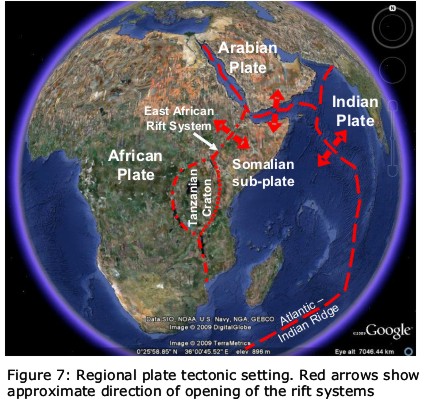Main Ethiopian Rift (non-technical)
Geology of the Main Ethiopian Rift
The Afar region is known as a triple junction – that is where three plate boundaries meet. The Red Sea and the Gulf of Aden form two arms of this triple junction and the third arm is the East African Rift system. The East African rift system extends through Ethiopia and Kenya and branches round the Tanzanian Craton before dying out in Mozambique (Figure 7). The northernmost part is known as the Main Ethiopian rift which opens out into the Afar Depression. It is bound to the north by the Ethiopian Plateau and to the south by the Somalian Plateau.
Extension between the Nubian and Somalian plates beginning about 25Ma lead to rifting along the East African rift system. Rifting across the southern part of the Main Ethiopian rift began by about 18Ma and by about 11Ma across the northern part of the rift when it propagated northwards across older Red Sea/Gulf of Aden structures to form the Afar triple junction.
The Main Ethiopian rift is a valley some 84km wide and is extending ESE-WNW at a rate of about 2.5mm/yr. The rift is bordered by large, Miocene aged faults. Within the main rift are a series of offset Quaternary rift basins bound by faults and intruded by dykes. These are known as magmatic segments as in the Afar Depression. The magmatic segments are typically about 20km wide and 60km long faulted and are the beginnings of oceanic spreading centres. Also as in the Afar Depression, the large Miocene border faults are now inactive and extension occurs along the magmatic segments.
For references used, please see technical version.
Structural Geology of the Afar Region
Ethiopian and Somalian plateaux
Southern Red Sea and Gulf of Aden
